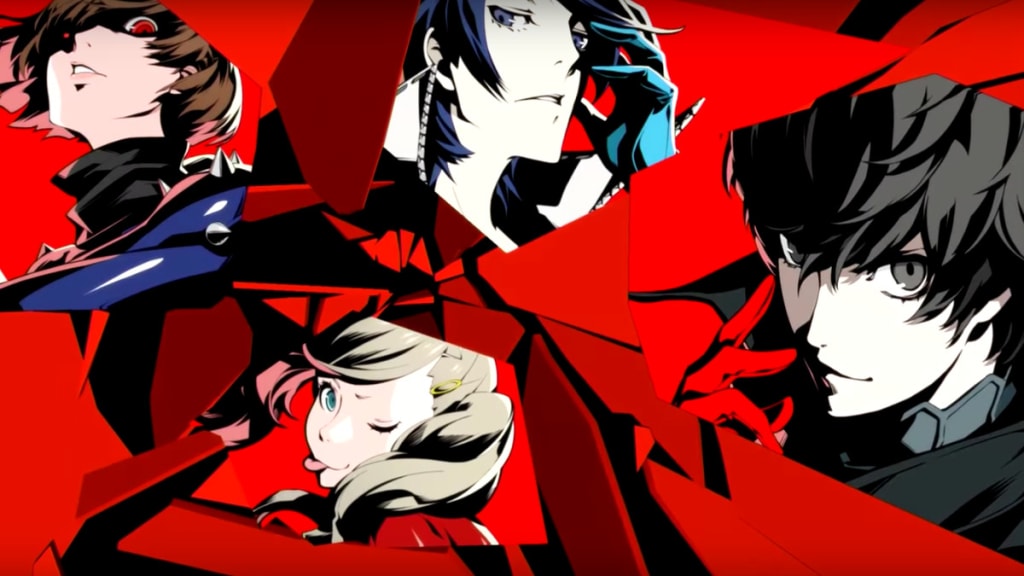'Persona 5' Review
The Modern JRPG Revolution

In an age where Final Fantasy’s success is hit or miss, one may wonder what franchise is going to truly lead the evolution of Japanese role-playing games? Persona 5, which is the fifth, sixth, and seventh Persona game, depending on who you ask, breaks away almost completely from the Megami Tensei parent series, and presents the player with what I can best describe as a Sly Cooper-esque RPG, crossed with Inception and previous Persona games’ fundamental mechanics. Persona 5’s identity is so fully realized that it’s still hard to believe it exists in the same realm as Persona 3 and four, let alone anything before those two. This feels like the game that JRPG fans have been waiting many years for. This game marks a turning point for its franchise, as it is now more publicly recognized than ever. Atlus gave this game their full attention, taking what was once a niche, budget sub-series of theirs into a full-blown, large scale and complex game, that feels like an incredibly high point of their development efforts thus far.
You are a transfer student on probation, attending a school in Shibuya, Japan called Shujin Academy. As you start to get used to the city (and your probation officer’s attic), thanks to a mysterious app on your phone, you discover the ability to enter the Metaverse, which is a cognitive world where the true feelings of individuals are brought to life, and their distorted desires take shape. You meet new friends, who get the app from you as well, and they all gain the ability to summon Personas, the spiritual manifestations of their inner feelings, to fight Shadows. With these newfound powers, the protagonist and his friends become the Phantom Thieves, a group who steals the hearts of corrupt adults inside the Metaverse.
The minds of the adults you travel to make for some interesting level design concepts for dungeons. The last two games in the franchise had mostly randomized dungeon maps, as a result of their more budgeted development, but almost all of Persona 5’s dungeons (known as Palaces) are hand-crafted, and somewhat Zelda-like in presentation, though streamlined and straightforward, without nearly as much thought. You’ll be in a castle backdrop one month, and a corrupt art museum on another. These Palaces are where you experience half of the gameplay. Elements of stealth are peppered through Persona 5, with stealth takedowns used as the method for ambushing enemies. It’s incredibly clever, and the overall “thief” aesthetic to the game compliments the Persona franchise perfectly, and I can’t believe it took this long for Atlus to take advantage of such a concept.
Battles are turn-based with similar mechanics to past games, with the addition of guns and two new elements: Psi and Nuclear. You’ll be doing a lot of fighting in Persona 5, and the combat system of past games has been perfected. Battles usually consist of four party members, using their Personas to cast spells, finding enemy weaknesses, and then delivering an all-out-attack with your party. The game uses a variant of the Shin Megami Tensei press-turn battle system, a battle system that rewards exploiting enemy weaknesses with an extra turn in combat. The catch is, the enemy has the potential to take advantage of this, too. It’s a proven battle style, that really feels satisfying, and nothing is more addicting than delivering the goods to an enemy, and then using an all-out attack, then being rewarded with a screen with the character responsible for finding the weakness posing stylishly, followed by the fanfare theme with all your spoils. However, as much fun as the combat can be, much of my time with the Palaces (the later ones especially) began to drag out in length with some padded areas, and fatigued me. That being said, the game is incredibly long, but even when you’re sick of the same environments, it’s not easy to put the game down.
Shadows are the mob enemies you fight in the game, but most of them can be recruited as new Personas that you can fuse to make ones with better fighting potential and abilities. The Personas are usually based off of religious, mythological beings from many world cultures, as well as some original ones. Much of them are reused character models from Atlus’ many, many Shin Megami Tensei games from the PS2 era, but they have been updated to fit the colorful aesthetic of Persona 5. An interesting mechanic from other SMT games that the Persona franchise hasn’t utilized since Persona 2 is negotiation, a system where you have to convince the enemy to join you, rather than doing something like throwing Pokeballs at them. It’s not new, but it’s different and engaging, and gives the monsters you fight more personality.
On the other half of the game, Persona 5 uses the day-by-day time management gameplay of previous games, but the world is much more open than ever. Calling it “open world” is an immense overstatement, but it certainly is the biggest overworld the series has seen, in terms of breadth of content. You can fish, get food, hang out with friends, go to school, and do tons of other little things that quickly get you caught up in a “I’ll just do one more day” attitude. The two main purposes of this half of this game is to increase different social stats, and upgrading Confidant ranks. Confidants are Persona 5’s rebranding of Social Links, which were side stories of people you meet in the town you run around in. However, the perks gained from hanging out with them in Persona 5 is much more worthwhile than in past games.
Confidant ranks go from one to 10, and the higher they are, the better Personas you can make, and the more combat perks you can gain. For example, one Confidant, Hifumi Togo, has a perk that allows you to switch out any party member mid-battle, regardless of whose turn it is (which is seen as somewhat of an exploit in this combat system). Social stats determine what you’re able to do, in terms of who you can hang out with, and what items you can gain in the overworld. My only issue with this half of the game is that Confidants can be so incredibly tedious when increasing their values. I actually went months without talking to some characters, and as a result, many of the characters I prioritized to take part in their lower-scale plots did not get their values maxed out. That blame can also be aimed at me, however, and this is really one of the only frustrating aspects of the game.
The plot is very fresh for Persona, yet still very familiar to past games. Atlus has proven themselves as master role-playing storytellers, with great voice acting and twists and turns abound. The characters, while somewhat archetypal, are memorable and distinct enough from past games, and really feel like good friends of yours, by the end of the game. However, I advise that if you even have the slightest interest in playing the game at any point in your life, whether it’s tomorrow or when you’re sixty, avoid spoiling it at all costs, as the game is so story heavy that it can be somewhat classified as a visual novel, and it was designed to be experienced blind, and to surprise you.
In terms of sound design, the soundtrack is probably one of my favorites in a video game. I’m listening to “Rivers in the Desert” on repeat as I type this, and I’ve been listening to the game’s music consistently for almost a month now. Composer Shoji Meguro is absolutely brilliant in this game, with probably the most memorable game soundtrack I’ve heard in years. The acid-jazz style feels very fitting to the game’s tone, and it goes perfectly with the game’s sheer sense of style. Even the clicks you hear from pressing X on the dialogue boxes is satisfying, and the sound design works well to give the combat much of its addictive qualities, as hitting weaknesses, and critical hits have genuinely pleasing sounds that compliment them perfectly. The graphical jump this game has over its precursors is astounding, with an anime aesthetic, heavy uses of the color red, and stunning UI. I’ve never thought I’d praise a game for something like its menus and heads-up display, but Persona 5 deserves it. All aspects of its art design, whether it be its cel-shaded graphics, incredible music, interface, or story meshes together so cohesively that I am floored by how much of an identity this game has. It sets an entirely new standard, even if the game’s graphical engine isn’t pushing the hardware much.
Persona 5 is such a massive game that I still can’t believe that it was developed in the long amount of time it was. Is it the best JRPG ever made? That’s entirely subjective. It certainly does what it does better than most of the competition of late, and is of my highest recommendation. While the Palaces drag in some parts, this story is more than worth experiencing, and whether you play it now or one of its inevitable re-releases, do yourself a service and make sure you know little going in. It’s a long, long game too, but it will stick with you. Some parts of the game are somewhat padded, but all of that is easily forgivable in the end. I am happy to say that Persona 5 feels like the game Persona has always had the potential to be, I just have no idea how Atlus is going to follow up to it after such high highs. Persona 5 is defiant, colorful, and confident. It’s not a reinvention of the wheel, but it’s damn close to the perfection of it. It stands out so well, that you can almost hear it mocking Square Enix.
9.5/10
About the Creator
Kevin Resnick
3D Artist and Illustrator based in Chicago, IL. Passionate about video games and media, and lover of storytelling.






Comments
There are no comments for this story
Be the first to respond and start the conversation.